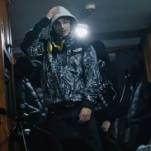How The Batman's production designer "evolved the map of Gotham"
Turns out the way to design a new world for a new Bruce Wayne is simple: figure out what his Batmobile looks like

Talk about a double-edged Batarang: When production designer James Chinlund got the call from his friend, filmmaker Matt Reeves—the two had previously collaborated on Dawn Of The Planet Of The Apes and War For The Planet Of The Apes—with an offer to join him on designing the world of the Robert Pattinson-starring The Batman, everything from the cityscape of Gotham to a brand-new Batmobile, the pros and cons were immediately and abundantly apparent.
On the one hand, Chinlund—whose two-decade-plus résumé includes everything from avant-garde art house fare like Requiem For A Dream to superheroic spectacle like The Avengers—would have the unenviable task of envisioning a world distinct from the many previous film and TV iterations of the Dark Knight’s environs and arsenal, yet still familiar to generations of die-hard and casual fans of the 83-year-old comic book icon. On the other hand, as just such a fan—The Batman! Gotham City! The Batmobile!—Chinlund couldn’t resist taking the leap.
With The Batman available on 4K Ultra HD and Blu-ray beginning May 24, Chinlund’s imaginative, intensely thought-through take on the Caped Crusader’s world is now freeze-frameable for delirious inspection. Chinlund joined The A.V. Club for a peak inside his creative inspiration.
The A.V. Club: There’s so much possibility with a Batman movie, so many different places to look for inspiration and directions to move in. How did you wrap your head around what you wanted to zero in on?
James Chinlund: Yes. It’s a funny thing, really: I think there are two ways of looking at it. You can take all the Gothams and you can take all the Batmobiles and lay them out on the wall. And I think for me, the key in was really the car… Because I think it’s very overwhelming, obviously, going in and saying, “Could we do that? Or could we do that?” But when you actually see the designs of the cars that came before us and what they said about their films and their Batman, I think Matt and I realized early on that our car was going to explain Bruce’s ethos.
And so as we started to unpack the design of the car, I think the design of the film and the world around it fell into place in the same way, just step by step. What are the choices that would lead us into the world? Where does Bruce live? What does that say about Bruce? Where is the Batcave? What kind of cave would this be? What does that say about Bruce? And then I think as you start making those designs, it’s like shining a light into the darkness, things start to reveal themselves. And that’s the path that we took.
AVC: What turned out to be unexpectedly challenging on this film, and what turned out to be a real unexpected joy?
JC: Well, I think making a film in COVID was absolutely the worst, you know? We had big crowd sequences and things that really were impacted, and it was a scary, scary time. So I think there was a moment coming back from COVID when the teaser dropped and we felt the fans’ reactions. And that was just such an exciting and exhilarating moment for us, it carried us through this long dark second half of the making of the film. Just knowing that the fans were out there and so excited about what we were doing, it really carried us through.
And I think in terms of what was rewarding and fun, I think for me, just working with the amazing teams in the U.K., in terms of the construction and design of the film. We built a huge backlot for the Iceberg Lounge, and the puzzle of that whole world, bringing that together, seeing those sets come together was just… It was a dream come true! The level of the craft and craftsmanship over there is just unbelievable.








































